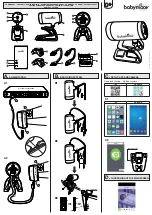
DN:KD-7961N-SMSY01 V3.0
Operation Guide
Template version:1
5/15
10. Blood pressure measurements determined by this monitor are equivalent to those obtained by a trained
observer using the cuff/stethoscope auscultation method, within the limits prescribed by the American
National Standard Institute, Electronic or automated sphygmomanometers.
11. Information regarding potential electromagnetic or other interference between the blood pressure monitor
and other devices together with advice regarding avoidance of such interference please see part
ELECTROMAGNETIC COMPATIBILITY INFORMATION.
12. If Irregular Heartbeat (IHB) brought by common arrhythmias is detected in the procedure of blood pressure
measurement, a signal of
will be displayed. Under this condition, the Electronic Sphygmomanometer
can keep function, but the results may not be accurate, it’s suggested that you consult with your physician
for accurate assessment.
There are 2 conditions under which the signal of IHB will be displayed:
1) The coefficient of variation (CV) of pulse period >25%.
2) The difference of adjacent pulse period≥0.14s, and the number of such pulse takes more than 53
percentage of the total number of pulse.
13. Please do not use the cuff other than supplied by the manufacturer, otherwise it may bring biocompatible
hazard and might result in measurement error.
14.
The monitor might not meet its performance specifications or cause safety hazard if stored or used
outside the specified temperature and humidity ranges in specifications.
15.
Please do not share the cuff with other infective person to avoid cross-infection.
16. This blood pressure monitor is verified by auscultatory method. It is recommended that you check annex B
of ANSI/AAMI SP-10:2002+A1:2003+A2:2006 for details of verification method if you need.
17. This equipment has been tested and found to comply with the limits for a Class B digital device, pursuant to
part 15 of the FCC Rules. These limits are designed to provide reasonable protection against harmful
interference in a residential installation. This equipment generates, uses and can radiate radio frequency
energy and, if not installed and used in accordance with the instructions, may cause harmful interference to
radio communications. However, there is no guarantee that interference will not occur in a particular
installation. If this equipment does cause harmful interference to radio or television reception, which can be
determined by turning the equipment off and on, the user is encouraged to try to correct the interference by
one or more of the following measures:
—Reorient or relocate the receiving antenna.
—Increase the separation between the equipment and receiver.
—Connect the equipment into an outlet on a circuit different from that to which the receiver is connected.
—Consult the dealer or an experienced radio/TV technician for help.
SETUP AND OPERATING PROCEDURES
1. BATTERY LOADING
a. Open battery cover at the back of the monitor.
b.
Load two ―AAA‖ size batteries. Please pay attention to polarity.
c. Close the battery cover.
When LCD shows battery symbol
, replace all batteries with new ones.
Rechargeable batteries are not suitable for this monitor.

































